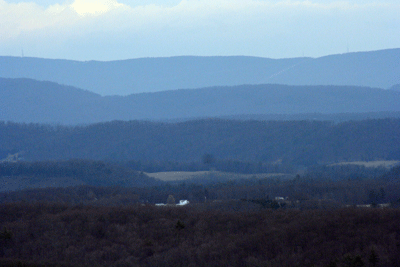Welcome to Module 4!
Mountain Building, Obduction, & Tsunamis
Introducing Obduction

"No matter how sophisticated you may be, a large granite mountain cannot be denied—it speaks in silence to the very core of your being."
—Ansel Adams, The Spirit of the Mountains(link is external)
Video: Introduction to Module 4 (1:29)
The Great Smokies are geologically attached to the whole Appalachian mountain range, including the ridges near Penn State’s University Park campus. There, if you’re so inclined, you can visit the beach in the mountains—all thanks to Africa.
We saw in Module 3 that an old, cold sea floor is subducted beneath the warmer sea floor or a continent, but what happens when a high-floating continent or island arc tries to go down beneath another continent or island arc?
In this module, we’ll see that the answer is obduction, a BIG collision. The Great Smoky Mountains, Mt. Nittany near Penn State's University Park campus, and all the rest of the Appalachians were formed by just such a collision, between North America on one side, and Africa and Europe on the other side. Folding and thrust-faulting in the collision zone thickened and shortened the crust and upper mantle. This produced high mountains—probably about as tall as the Andes today. And, as we will discuss, high mountain peaks float on deep roots. When erosion lowers a mountain range, the root floats up, bringing metamorphic rocks to the surface that have been "cooked" by heat and pressure deep within the Earth.
Before we go any further, look at the following short video introduction by Dr. Anandakrishnan.
Video: Duck Mountain (2:23)
And....A Word About Tsunamis
Plate tectonics causes earthquakes, volcanic explosions, and steep slopes that can experience landslides. If any of these happen under the ocean or in a deep lake, or if a landslide falls into an ocean or lake, a lot of water can be moved in a hurry. The resulting great waves are called tsunamis and can have catastrophic consequences. Fortunately, warning systems can be devised to reduce the loss of life, and we can use our knowledge to build in ways that increase safety for people and property. We'll look at some of these issues as we wrap up our multi-week exploration of Plate Tectonics and Mountain Building.
Learning Objectives
- Identify the push-together faults and folds formed in obduction zones when continents or island arcs collide.
- Explain the three basic tectonic styles: pull-apart, push-together, and slide-past.
- Explain how obduction zones can produce thickening of the crust that leads to the formation of metamorphic rocks.
- Explain how erosion can reveal metamorphic rocks formed in obduction zones.
- Explain how tsunamis are caused, and why they are dangerous.
What to do for Module 4?
You will have one week to complete Module 4. See the course calendar in Canvas for specific due dates.
- Take the RockOn #4 Quiz.
- Take the StudentsSpeak #5 Survey.
- Continue working on Exercise #2: Geology is All Around You.
Questions?
If you have any questions, send an email via Canvas, to ALL the Teachers and TAs. To do this, add each teacher individually in the “To” line of your email. By adding all the teachers, the TAs will be included. Failure to email ALL the teachers may result in a delayed or missed response. For detailed directions on how to do this, see How to send an email in GEOSC 10 in the Important Information module.

This course is offered as part of the Repository of Open and Affordable Materials(link is external) at Penn State. You are welcome to use and reuse materials that appear on this site (other than those copyrighted by others) subject to the licensing agreement linked to the bottom of this and every page. Students who register for this Penn State course gain access to assignments and instructor feedback and earn academic credit. Information about registering for this course is available from the Office of the University Registrar(link is external).